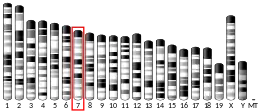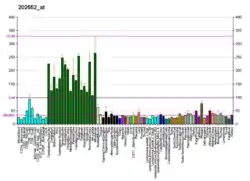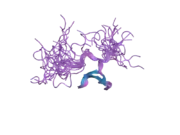Amyloid beta A4 precursor protein-binding family B member 1 is a protein that in humans is encoded by the APBB1 gene.[5][6][7]
Function
The protein encoded by this gene is a member of the Fe65 protein family. It is an adaptor protein localized in the nucleus. It interacts with the Alzheimer's disease amyloid precursor protein (APP), transcription factor CP2/LSF/LBP1 and the low-density lipoprotein receptor-related protein. APP functions as a cytosolic anchoring site that can prevent the gene product's nuclear translocation. This encoded protein could play an important role in the pathogenesis of Alzheimer's disease. It is thought to regulate transcription. Also it is observed to block cell cycle progression by downregulating thymidylate synthase expression. Multiple alternatively spliced transcript variants have been described for this gene but some of their full length sequence is not known.[7]
Interactions
APBB1 has been shown to interact with APLP2,[8][9] TFCP2,[10] LRP1[11] and Amyloid precursor protein.[8][9][11][12][13]
References
- 1 2 3 GRCh38: Ensembl release 89: ENSG00000166313 - Ensembl, May 2017
- 1 2 3 GRCm38: Ensembl release 89: ENSMUSG00000037032 - Ensembl, May 2017
- ↑ "Human PubMed Reference:". National Center for Biotechnology Information, U.S. National Library of Medicine.
- ↑ "Mouse PubMed Reference:". National Center for Biotechnology Information, U.S. National Library of Medicine.
- ↑ McLoughlin DM, Miller CC (Jan 1997). "The intracellular cytoplasmic domain of the Alzheimer's disease amyloid precursor protein interacts with phosphotyrosine-binding domain proteins in the yeast two-hybrid system". FEBS Lett. 397 (2–3): 197–200. doi:10.1016/S0014-5793(96)01128-3. PMID 8955346.
- ↑ Bressler SL, Gray MD, Sopher BL, Hu Q, Hearn MG, Pham DG, Dinulos MB, Fukuchi K, Sisodia SS, Miller MA, Disteche CM, Martin GM (Feb 1997). "cDNA cloning and chromosome mapping of the human Fe65 gene: interaction of the conserved cytoplasmic domains of the human beta-amyloid precursor protein and its homologues with the mouse Fe65 protein". Hum Mol Genet. 5 (10): 1589–98. doi:10.1093/hmg/5.10.1589. PMID 8894693.
- 1 2 "Entrez Gene: APBB1 amyloid beta (A4) precursor protein-binding, family B, member 1 (Fe65)".
- 1 2 Guénette SY, Chen J, Jondro PD, Tanzi RE (Oct 1996). "Association of a novel human FE65-like protein with the cytoplasmic domain of the beta-amyloid precursor protein". Proceedings of the National Academy of Sciences of the United States of America. 93 (20): 10832–7. Bibcode:1996PNAS...9310832G. doi:10.1073/pnas.93.20.10832. PMC 38241. PMID 8855266.
- 1 2 Tanahashi H, Tabira T (Feb 1999). "Molecular cloning of human Fe65L2 and its interaction with the Alzheimer's beta-amyloid precursor protein". Neurosci. Lett. 261 (3): 143–6. doi:10.1016/S0304-3940(98)00995-1. PMID 10081969. S2CID 54307954.
- ↑ Zambrano N, Minopoli G, de Candia P, Russo T (Aug 1998). "The Fe65 adaptor protein interacts through its PID1 domain with the transcription factor CP2/LSF/LBP1". J. Biol. Chem. 273 (32): 20128–33. doi:10.1074/jbc.273.32.20128. PMID 9685356.
- 1 2 Trommsdorff M, Borg JP, Margolis B, Herz J (Dec 1998). "Interaction of cytosolic adaptor proteins with neuronal apolipoprotein E receptors and the amyloid precursor protein". J. Biol. Chem. 273 (50): 33556–60. doi:10.1074/jbc.273.50.33556. PMID 9837937.
- ↑ Borg JP, Ooi J, Levy E, Margolis B (Nov 1996). "The phosphotyrosine interaction domains of X11 and FE65 bind to distinct sites on the YENPTY motif of amyloid precursor protein". Mol. Cell. Biol. 16 (11): 6229–41. doi:10.1128/mcb.16.11.6229. PMC 231626. PMID 8887653.
- ↑ Zambrano N, Buxbaum JD, Minopoli G, Fiore F, De Candia P, De Renzis S, Faraonio R, Sabo S, Cheetham J, Sudol M, Russo T (Mar 1997). "Interaction of the phosphotyrosine interaction/phosphotyrosine binding-related domains of Fe65 with wild-type and mutant Alzheimer's beta-amyloid precursor proteins". J. Biol. Chem. 272 (10): 6399–405. doi:10.1074/jbc.272.10.6399. PMID 9045663.
External links
- Human APBB1 genome location and APBB1 gene details page in the UCSC Genome Browser.
Further reading
- Russo T, Faraonio R, Minopoli G, De Candia P, De Renzis S, Zambrano N (1998). "Fe65 and the protein network centered around the cytosolic domain of the Alzheimer's beta-amyloid precursor protein". FEBS Lett. 434 (1–2): 1–7. doi:10.1016/S0014-5793(98)00941-7. PMID 9738440. S2CID 24288811.
- Askanas V, Engel WK (2004). "Proposed pathogenetic cascade of inclusion-body myositis: importance of amyloid-beta, misfolded proteins, predisposing genes, and aging". Current Opinion in Rheumatology. 15 (6): 737–44. doi:10.1097/00002281-200311000-00009. PMID 14569203. S2CID 23763978.
- Borg JP, Ooi J, Levy E, Margolis B (1996). "The phosphotyrosine interaction domains of X11 and FE65 bind to distinct sites on the YENPTY motif of amyloid precursor protein". Mol. Cell. Biol. 16 (11): 6229–41. doi:10.1128/mcb.16.11.6229. PMC 231626. PMID 8887653.
- Zambrano N, Buxbaum JD, Minopoli G, Fiore F, De Candia P, De Renzis S, Faraonio R, Sabo S, Cheetham J, Sudol M, Russo T (1997). "Interaction of the phosphotyrosine interaction/phosphotyrosine binding-related domains of Fe65 with wild-type and mutant Alzheimer's beta-amyloid precursor proteins". J. Biol. Chem. 272 (10): 6399–405. doi:10.1074/jbc.272.10.6399. PMID 9045663.
- Ermekova KS, Zambrano N, Linn H, Minopoli G, Gertler F, Russo T, Sudol M (1998). "The WW domain of neural protein FE65 interacts with proline-rich motifs in Mena, the mammalian homolog of Drosophila enabled". J. Biol. Chem. 272 (52): 32869–77. doi:10.1074/jbc.272.52.32869. PMID 9407065.
- Duilio A, Faraonio R, Minopoli G, Zambrano N, Russo T (1998). "Fe65L2: a new member of the Fe65 protein family interacting with the intracellular domain of the Alzheimer's beta-amyloid precursor protein". Biochem. J. 330 (Pt 1): 513–9. doi:10.1042/bj3300513. PMC 1219167. PMID 9461550.
- Blanco G, Irving NG, Brown SD, Miller CC, McLoughlin DM (1998). "Mapping of the human and murine X11-like genes (APBA2 and apba2), the murine Fe65 gene (Apbb1), and the human Fe65-like gene (APBB2): genes encoding phosphotyrosine-binding domain proteins that interact with the Alzheimer's disease amyloid precursor protein". Mamm. Genome. 9 (6): 473–5. doi:10.1007/s003359900800. PMID 9585438. S2CID 31066473.
- Zambrano N, Minopoli G, de Candia P, Russo T (1998). "The Fe65 adaptor protein interacts through its PID1 domain with the transcription factor CP2/LSF/LBP1". J. Biol. Chem. 273 (32): 20128–33. doi:10.1074/jbc.273.32.20128. PMID 9685356.
- Hu Q, Kukull WA, Bressler SL, Gray MD, Cam JA, Larson EB, Martin GM, Deeb SS (1998). "The human FE65 gene: genomic structure and an intronic biallelic polymorphism associated with sporadic dementia of the Alzheimer type". Hum. Genet. 103 (3): 295–303. doi:10.1007/s004390050820. PMID 9799084. S2CID 22957756.
- Trommsdorff M, Borg JP, Margolis B, Herz J (1999). "Interaction of cytosolic adaptor proteins with neuronal apolipoprotein E receptors and the amyloid precursor protein". J. Biol. Chem. 273 (50): 33556–60. doi:10.1074/jbc.273.50.33556. PMID 9837937.
- Sabo SL, Lanier LM, Ikin AF, Khorkova O, Sahasrabudhe S, Greengard P, Buxbaum JD (1999). "Regulation of beta-amyloid secretion by FE65, an amyloid protein precursor-binding protein". J. Biol. Chem. 274 (12): 7952–7. doi:10.1074/jbc.274.12.7952. PMID 10075692.
- Hu Q, Hearn MG, Jin LW, Bressler SL, Martin GM (2000). "Alternatively spliced isoforms of FE65 serve as neuron-specific and non-neuronal markers". J. Neurosci. Res. 58 (5): 632–40. doi:10.1002/(SICI)1097-4547(19991201)58:5<632::AID-JNR4>3.0.CO;2-P. PMID 10561691. S2CID 33553183.
- Lambrechts A, Kwiatkowski AV, Lanier LM, Bear JE, Vandekerckhove J, Ampe C, Gertler FB (2000). "cAMP-dependent protein kinase phosphorylation of EVL, a Mena/VASP relative, regulates its interaction with actin and SH3 domains". J. Biol. Chem. 275 (46): 36143–51. doi:10.1074/jbc.M006274200. PMID 10945997.
- Minopoli G, de Candia P, Bonetti A, Faraonio R, Zambrano N, Russo T (2001). "The beta-amyloid precursor protein functions as a cytosolic anchoring site that prevents Fe65 nuclear translocation". J. Biol. Chem. 276 (9): 6545–50. doi:10.1074/jbc.M007340200. PMID 11085987.
- Lau KF, McLoughlin DM, Standen CL, Irving NG, Miller CC (2001). "Fe65 and X11beta co-localize with and compete for binding to the amyloid precursor protein". NeuroReport. 11 (16): 3607–10. doi:10.1097/00001756-200011090-00041. PMID 11095528.
- McLoughlin DM, Standen CL, Lau KF, Ackerley S, Bartnikas TP, Gitlin JD, Miller CC (2001). "The neuronal adaptor protein X11alpha interacts with the copper chaperone for SOD1 and regulates SOD1 activity". J. Biol. Chem. 276 (12): 9303–7. doi:10.1074/jbc.M010023200. PMID 11115513.
- Zambrano N, Bruni P, Minopoli G, Mosca R, Molino D, Russo C, Schettini G, Sudol M, Russo T (2001). "The beta-amyloid precursor protein APP is tyrosine-phosphorylated in cells expressing a constitutively active form of the Abl protoncogene". J. Biol. Chem. 276 (23): 19787–92. doi:10.1074/jbc.M100792200. PMID 11279131.






